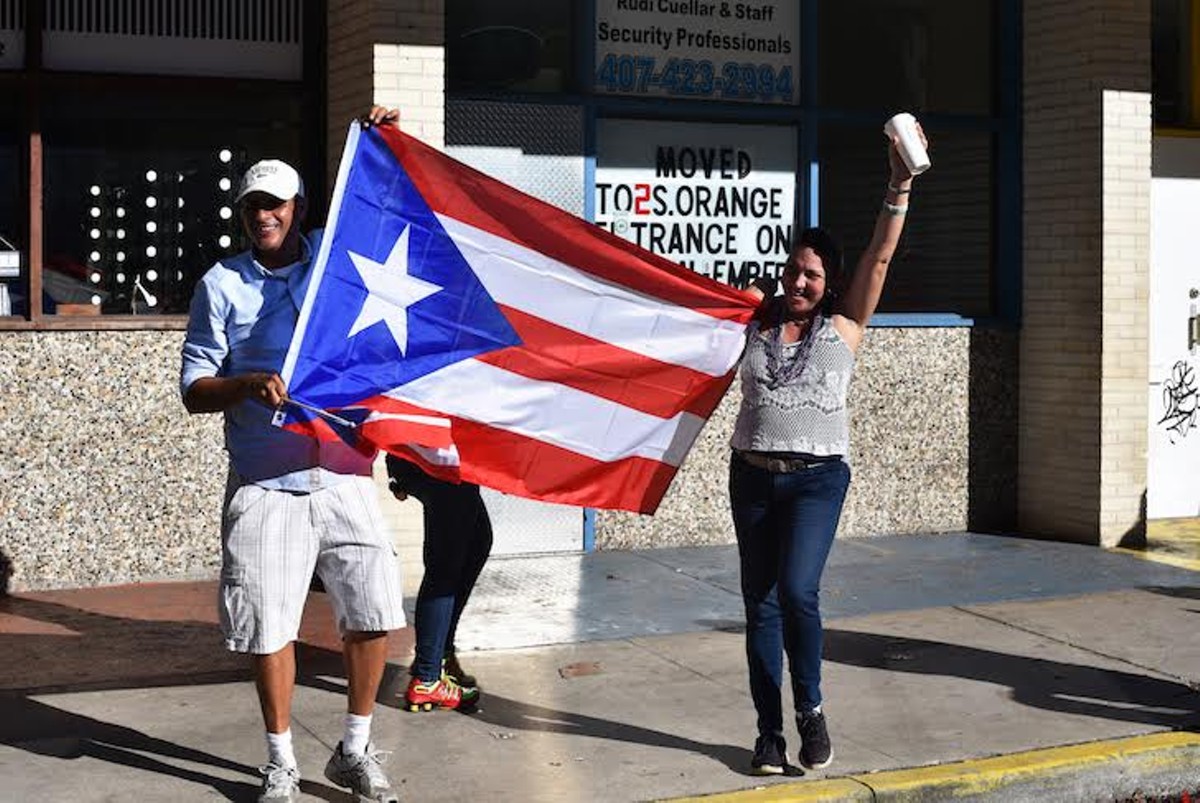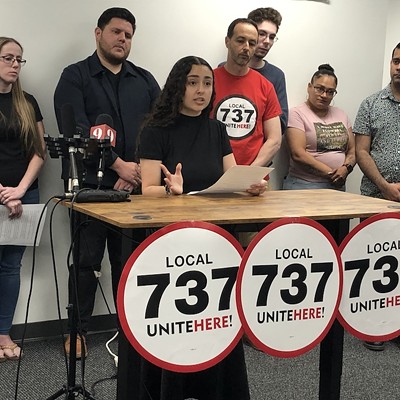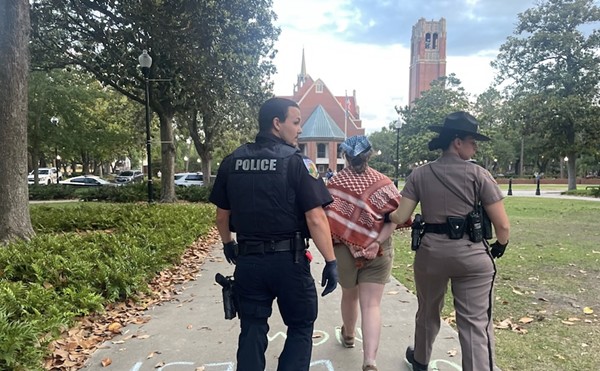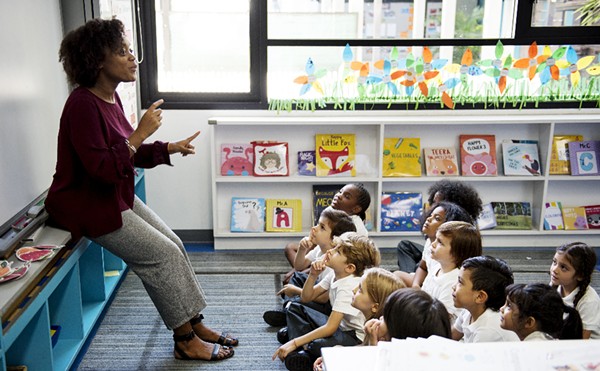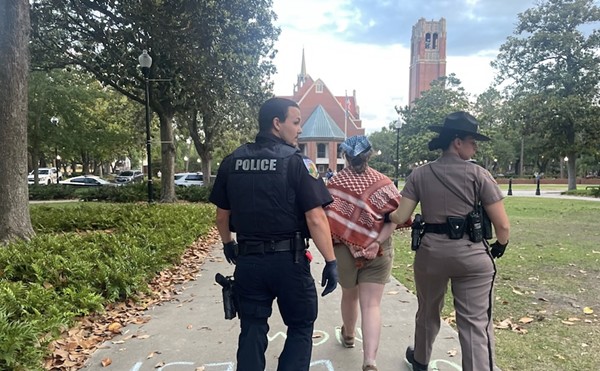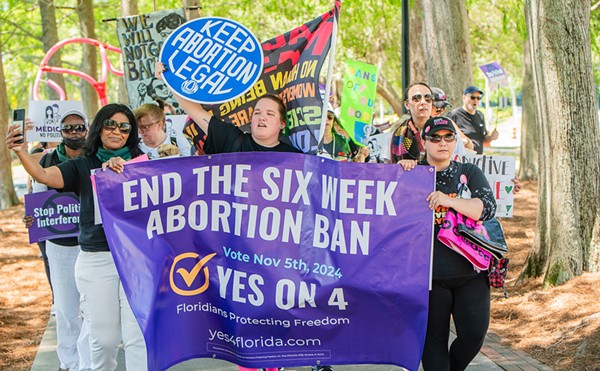As dozens of exhausted newcomers disembarked from a plane from San Juan into the air-conditioned terminal of the Orlando International Airport last week, one of the first faces they saw belonged to Carmen Santiago.
Santiago held up a small sheet of paper with the eye-catching star and stripes of the Puerto Rican flag. Underneath, a message read, "Bienvenido a Orlando. ¿Usted necesita ayuda?" (Welcome to Orlando. Do you need help?)
Most people asked her where they can find the help. Others couldn't say a word, Santiago says.
"A lot of people are coming with a lot of trauma from everything that's happened to them," she says in Spanish. "Sometimes, they can't speak – they just start crying the moment they see the flag on the paper. Sometimes they throw themselves on you because they need a hug."
Santiago is one of about 50 people from Calvario City Church helping direct Puerto Rican evacuees toward the disaster relief center inside the airport set up by state and local officials to help find resources for hurricane victims relocating to Central Florida. Almost a month after Hurricane Maria ripped through Puerto Rico, the island is still recovering from the destruction and its residents are living in deteriorating conditions.
Most of the 3.4 million American citizens who live in the U.S. territory remain without electricity and will probably be without power for months. Thousands don't have potable water to drink – some have even gone so far as to collect spring water with makeshift spigots. The desperation is so intense that the federal Environmental Protection Agency warned Puerto Ricans to stop drinking water from toxic hazardous waste sites.
Last week's official death toll was 45, though that number will likely increase – people who have died have yet to be counted, and Puerto Rican officials are now dealing with potential disease outbreaks. The media organization Vox estimates the death toll may be closer to at least 450 people. The humanitarian crisis has only been exacerbated by public spats between President Donald Trump and Puerto Rican officials on how much help the federal government has rendered in the wake of the disaster.
Meanwhile, many Puerto Ricans have made the heartbreaking decision to leave their homes, either temporarily or permanently. Florida officials estimate that about 100,000 Puerto Ricans will migrate to the Sunshine State in coming months, including thousands of children and young adults who will enroll in local schools and public colleges, especially in the Orlando metro area, which already has a high Puerto Rican population.
State Rep. Bob Cortes and other Central Florida lawmakers of Puerto Rican descent are preparing for the influx of students in the local K-12 school system. The Longwood Republican and fellow legislators sent a letter Oct. 2 to state Education Commissioner Pam Stewart asking for a number of policies to help Puerto Rican students, including waiving requirements on records that may have been lost in the storm, suspending penalties for class-size infractions and allowing Puerto Rican teachers to continue their careers by making it easier for school districts to hire them.
Cortes says Stewart and Gov. Rick Scott were responsive to the request; they approved 20,000 spots for Puerto Rican students at the Florida Virtual School and mandated that all of Florida's public colleges and universities offer in-state tuition to Puerto Rican students impacted by Maria. Adrienne Frame, associate vice president and dean of students at the University of Central Florida, says the college expects students to enroll in the spring semester and the school is working with off-campus leasing agencies to get a sense of how much vacant housing will be available.
But Rep. Amy Mercado, D-Orlando, says there's more that could be done. Although some Puerto Rican K-12 students may already know English, the majority speak Spanish – and according to state rules, this group will have to take the standards assessment test in English.
"We're trying to be proactive in trying to figure out what our main needs are and how we're going to help facilitate student needs," she says. "Students should take the exams in a language they know, and we should give them the opportunity to take it in Spanish. It's been an issue in the past. We have a large population completing high school but getting a certificate of completion instead of a diploma because of these tests. Students need an education that helps them get back to a normal life routine."
Before Maria, Puerto Rican parents who migrated to Orange and Osceola counties because of the island's financial crisis were already complaining about a lack of school resources in Spanish. Wanda Ramos, a member of the diaspora-led coalition of organizations called Vamos4PR, says those resources are critical.
"A grandmother we know only spoke Spanish, and she was in charge of caring for her grandson, who spoke English," she says. "He got sick and had to take a medication to school, and when the nurse called to verify with the grandmother, she didn't understand her, and there was no one at the school who could help. The student had to end up translating. How can there be a verification of information in that situation?"
Linda Kobert, vice chair of the Orange County School Board, says several measures have been implemented since Spanish-speaking parents brought the issues to the district's attention, including monthly meetings and an outreach program to inform parents about the language resources available, an accurate translation of the Orange County Public Schools website and a contract with a multilingual translation phone line.
Last week, Kobert said Orange County Public Schools had enrolled 300 students from Puerto Rico and another 92 from the U.S. Virgin Islands, which were also hit hard by Hurricane Maria. OCPS has set up a booth inside the airport to help students enroll and has recruited some teachers, bus drivers and janitors on the spot. Dana Schafer, a spokesperson for the Osceola County School District, said it had enrolled 210 Puerto Rican students after Maria.
"First and foremost, we've made very clear as a board that we expect the district and staff to open their arms and welcome these children and their families," Kobert says. "We know they're arriving having gone through trauma and we want to do everything possible to support them."
Neither Orange nor Osceola County school officials know ultimately how many kids will enroll, though they expect that number will be in the thousands when humanitarian flights start leaving the island.
"Right now, the number of students is limited by the amount of people that can travel to the airport and out of Puerto Rico," says Kelvin Soto, chair of the Osceola County School Board. "Just 3,000 students – that's the number of students in a brand-new high school or two middle schools or four elementary schools. These are fellow American citizens suffering from a natural catastrophe through no fault of their own. They're not coming because they want. We have to pull together to help them through this difficult time."

